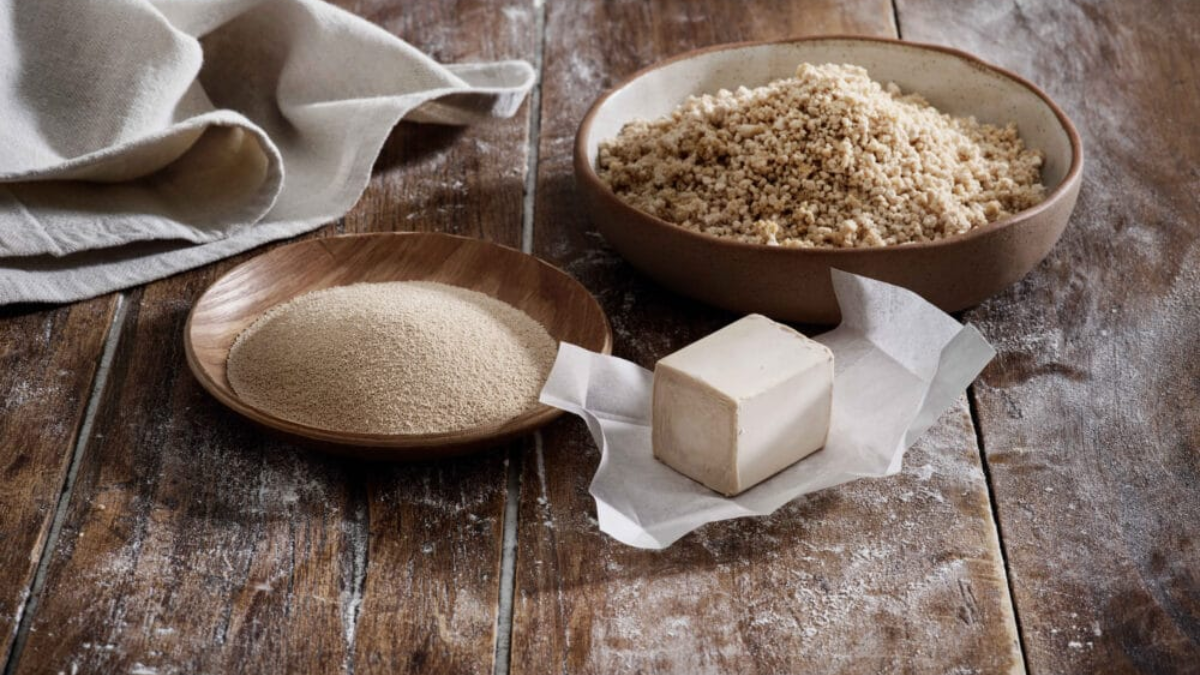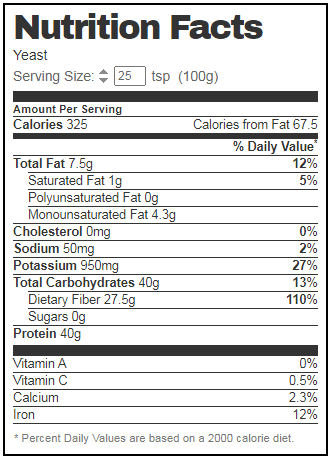Saccharomyces cerevisiae, the single-celled organism that makes up yeast, needs nutrients, temperature, and moisture to survive. It turns its food, sugar, and starch into alcohol and carbon dioxide through fermentation. Carbon dioxide is what causes baked items to rise. The yeast cell, which is smaller than a grain of sand and can only be seen under a microscope, is a tiny organism. Cake yeast to weigh one gram or 1/28 of an ounce; it requires 20,000,000,000 (twenty billion) yeast cells.
The skin of fruits and berries naturally contains yeast, which is also present in the soil and the air. It is still used to make bread, beer, wine, and other goods through natural fermentation. It is one of the first organisms to be domesticated. Yeast is a member of the fungus family and is accessible in your neighborhood grocery along with other edible fungi like mushrooms.
Yeast Nutrition Facts
What is Yeast?
A single-cell fungus with an egg-like shape called yeast can only be seen under a microscope. One gram of yeast weighs 20,000,000,000 (twenty billion) yeast cells. Yeast cells need the energy they get from food digestion to develop.
When yeast-leavened bread is baked, the yeast ferments the flour’s sugars and produces carbon dioxide. The carbon dioxide cannot escape because the dough is elastic and stretchable. The dough puffs up or rises as a result of the expanding gas. Additionally, yeast is a crucial component in the creation of beer. The yeast consumes beer’s sugar, creating carbon dioxide and alcohol.
Fresh yeast has a distinct flavor. It has a ripe aroma and a thick, almost bread-like flavor. It has a slightly raw, acidic flavor. Baking soda can be used in place of yeast. To match the amount of yeast in the recipe, combine equal parts of baking soda and lemon juice. You must incorporate acid into the mixture to achieve this.
What are the Different Types of Yeast?
There are two varieties of yeast: baker’s yeast, which is used as a leavening agent, and brewer’s yeast, a wet yeast principally utilized in beer production. Baker’s yeast comes in two varieties: fresh yeast and active dried yeast.
- Small square cakes formed with live yeast cells are known as fresh yeast, wet, cake, and compressed yeast. These blocks of fresh yeast, which professional bakers frequently use, are highly perishable because they contain 70% moisture.
- Dry yeast comes in two varieties: quick and active dry yeast. The size of the granules is the only distinction between the two; instant yeast has been ground to a finer texture than active yeast, which has larger granules.
- As opposed to active dry yeast, which needs to be dissolved in water before use, instant yeast can be added to other components.
- Active dry yeast is dormant until proven or dissolved in a tiny amount of warm water (about 110 degrees Fahrenheit).
- Additionally, instant yeast is marketed as rapidly rising. The dough will rise more quickly thanks to the enzymes and additions in this variety of yeast.
- When using rapid-rise yeast, the rising time for bread is cut in half. If the recipe calls for two rising times, you can skip the first one and immediately start kneading and shaping the loaves.
Uses of Yeast
In the natural world, yeasts are prevalent in situations with lots of sugar, such as the nectar of flowers. Commercially, yeasts’ capacity for fermenting sugars into alcohol and carbon dioxide, a kind of anaerobic respiration, is particularly significant. Yeasts can digest their weight in glucose each hour thanks to their high efficiency in this process. When nourishment is available, a yeast cell can quickly multiply into a colony of 100 million cells in just two or three days.
- Saccharomyces cerevisiae, which translates to “sugar fungus,” is the yeast species that uses fermentation to turn sugars from fruits or grains into alcohol and carbon dioxide in the manufacturing of alcoholic beverages, such as wine.
- Here, the practical consequence of fermentation is alcohol, while carbon dioxide is typically released as a waste product. Some outliers, such as champagne and beer, maintain carbon dioxide to give the drinks a bubbly texture.
- Contrarily, bakers use saccharomyces yeasts specifically for the carbon dioxide generated during the fermentation of flour’s carbohydrate content.
- Due to the carbon dioxide being trapped inside the dough, bubbles are formed. When heated, these bubbles enlarge and cause the bread to rise when baking, which makes the bread soft and spongy.
- The finished product is non-alcoholic since the alcohol created during fermentation is boiled out during baking.
- Another sort of yeast that is significant for commerce is nutritional yeast. When nutritional yeast is inactive (dead), it is eaten for flavor and nutrients.
- Nutritional yeast is a powdered product made from yeast strains isolated and combined with cornmeal or starch after being cultivated in nutritional mediums, including molasses, ammonia, and minerals.
- Nearly 50% of nutritional yeast comprises protein and contains sizeable niacin, folic acid, and B vitamins.
Additionally, yeasts are utilized as model organisms in science. More precisely, the structure and operation of chromosomes in eukaryotic species are studied using yeasts as models. Yeasts can also be examined to comprehend better human metabolic pathways, such as the pathways involved in the human brain system, because yeasts and mammals share a lot of genes and metabolic pathways.
How to Cook with Yeast?
You can quickly test your yeast to see if it is still alive. Add the yeast and a pinch of sugar to a basin with about 1/2 cup of lukewarm water. The yeast is active if it dissolves and the liquid bubbles after a few minutes of stirring.
Fresh yeast should be purchased in quantities that will be consumed promptly because it can only be kept in the refrigerator for up to three days if not immediately used. Ensure the dough rises at 70 to 80 degrees Fahrenheit since yeast needs warm temperatures to activate. Additionally, you might need to exercise more patience if your recipe calls for many eggs, butter, sugar, and milk because these ingredients slow down the leavening process.
Dry yeast smells less pleasant than fresh yeast cake. It has a delicate, crumbly color and a light beige hue. Fresh yeast cakes are kept in the dairy case next to the butter because they are highly perishable. However, they might not always be accessible there. One cake of fresh yeast is equivalent to one envelope of dry yeast, depending on the manufacturer (like Fleischmann’s). Otherwise, 2/3 ounces of fresh yeast is equivalent to 2 1/4 teaspoons of dried yeast. Price-wise, fresh yeast frequently costs more than active dry yeast.
What are the Health Benefits of Yeast?
Here are the health benefits of yeast:
It Keeps Things Running
Yeast-rich dishes provide a lot of proteins and B vitamins. Your digestive tract remains balanced and healthy, thanks to yeast. The proper dosage in your body aids in the operation of your immune system. In your stomach, yeast is a beneficial strain of bacteria. It can aid in illness prevention and even help you absorb vitamins and minerals from your diet.
Reduces Risk of Anemia
Iron is frequently the first nutrient that comes to mind when discussing anemia. Anemia is also brought on by a lack of vitamin B12 or folate. Injections are frequently used to treat vitamin B12 insufficiency; however, high oral dosages can also be helpful. Nutritional yeast can be a major source of vitamin B12 for people with a plant-based or vegan diet as they frequently have few other sources of this crucial ingredient. Ost brands of nutritional yeast are B12-fortified, offering more than 500% of the RDA per serving. B12 is water-soluble; thus, it is unlikely to be hazardous even when taken in high levels through food.
Aids Diabetes Management
In addition to aiding in digestion, fiber also prevents abrupt changes in blood sugar levels. Numerous studies have demonstrated that low-fiber eating regimens raise the risk of diabetes. Fiber reduces satiety and slows digestion, reducing appetite and food’s glycemic response. Fiber is helpful for both preventing diabetes and helping individuals who already have it to keep their readings in check. Nutritional yeast is a novel technique to increase the amount of fiber on your plate.
Conclusion
Making yeast is not a chemical process because it is a “living creature.” Instead, yeast must be grown to be made. Commercial yeast is produced by blending molasses with pure yeast cells that have been grown. The fermentation process—by which yeast is transformed into carbon dioxide and alcohol—can also occur in the natural world.
For example, when a ripe piece of fruit falls from a tree, splitting open to reveal its sugar-filled flesh. Fermentation occurs due to airborne yeast feeding on the fruit’s insides. Malt is a fermented grain that is frequently found in cereals and sweets. Yeast is an ingredient in bread, beer, and wine, among other foods and beverages. Additionally, made using yeast, including kombucha, soy sauce, and miso.



